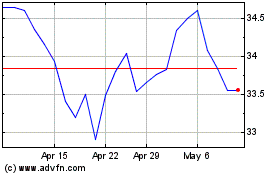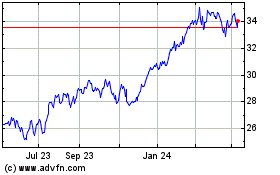NAB 1st Half Profit Up 19%, Increases Dividend -- Update
May 03 2023 - 6:13PM
Dow Jones News
By Alice Uribe
SYDNEY--National Australia Bank lifted its dividend by almost
14%, and reported a 19% increase in interim profit, helped partly
by a strong performance in its business banking unit and higher
interest rates.
Australia's second largest lender by market capitalization said
its net profit rose to 3.97 billion Australian dollars (US$2.64
billion) in the six months through March, from A$3.55 billion a
year prior. Analysts had expected an interim net profit of A$4.10
billion, according to FactSet's consensus estimate.
The bank declared an interim dividend of A$0.83 per share,
compared with A$0.73 a year earlier.
"Our results have benefited from the execution of our strategy
over multiple years. This includes consistent investment in
long-term growth opportunities, while making choices for more
targeted growth against the backdrop of a slowing economy and
increasing competition," said Chief Executive Ross McEwan. "The
higher interest rate environment has also been an important
near-term driver of revenue this period."
Cash earnings--a measure closely tracked by analysts that strips
out non-core items such as revenue hedges and treasury shares--rose
by 17% to A$4.07 billion.
NAB's business and private banking unit was a standout with
interim cash earnings up 20% to A$1.71 billion, but the lender's
personal banking unit saw a 0.4% drop in cash earnings to A$785
million for the first half, which it attributed partly to home
lending competition, offsetting the impact of the higher interest
rate environment.
NAB's half-year net interest margin--the difference between the
interest income generated and the amount of interest paid out to
lenders--rose 14 basis points to 1.77%
NAB, like other lenders, has benefited from the rising interest
rate environment. The Reserve Bank of Australia this week surprised
financial markets, raising its official cash rate by 25 basis
points to 3.85%, resuming an aggressive campaign of increases after
pausing in April.
But some analysts see that mortgage competition, particularly in
refinancing, may crimp future margins and earnings. At the same
time, banks may also see pressure on credit quality, as customers
grapple with higher mortgage repayments, inflation-related cost
squeezes.
NAB on Thursday said that there were signs that inflation is
beginning to moderate, which it said may mean Australia's official
cash rate is near its peak.
"While there is still uncertainty over the extent to which
higher interest and living costs will impact consumer spending, it
now seems increasingly likely that Australia will avoid a
pronounced economic correction," said NAB.
On capital, Mr. McEwan said levels were above NAB's targets,
while liquidity remained strong, with collective provision coverage
remaining well above pre Covid-19 levels. The lender's FY 2023 term
funding task is "well advanced," he said with A$23 billion raised
in the first half.
NAB's Common Equity Tier 1 capital ratio was 12.21%, down from
12.48% the previous year.
Write to Alice Uribe at alice.uribe@wsj.com
(END) Dow Jones Newswires
May 03, 2023 18:58 ET (22:58 GMT)
Copyright (c) 2023 Dow Jones & Company, Inc.
National Australia Bank (ASX:NAB)
Historical Stock Chart
From Nov 2024 to Dec 2024

National Australia Bank (ASX:NAB)
Historical Stock Chart
From Dec 2023 to Dec 2024
